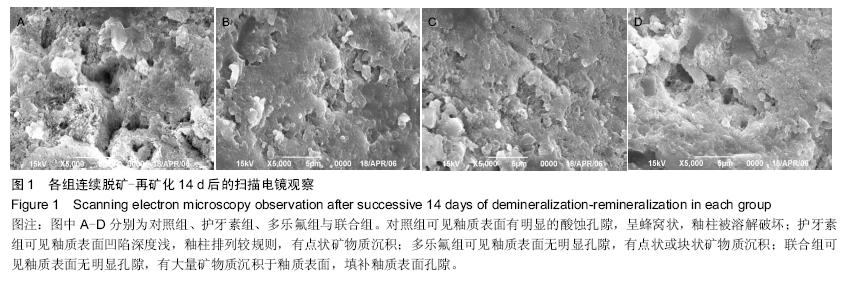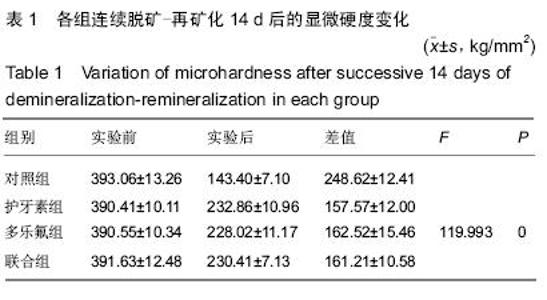[1] 招顺秀,李业荣,许碧晖.多乐氟预防固定正畸矫治中牙釉质脱矿的临床研究[J].广东牙病防治,2013,21(8):441-443.
[2] Nalbantgil D,Oztoprak MO,Cakan DG,et al.Prevention of demineralization around orthodontic brackets using tow different fluoride varnishes.Eur J Dent.2013;7(1):41-47.
[3] Pol TR,Naik CR,Gupta R,et al.Incorporation of casein phosphopeptide-amorphous calcium phosphate into glass-ionomer cement for orthodontic band cementation-an in vitro study.Int J Stomatol Res.2013;2:5-10.
[4] Tüfekçi E,Pennella DR,Mitchell JC,et al.Efficacy of a fluoride-releasing orthodontic primer in reducing demineralization around brackets: an in-vivo study. Am J Orthod Dentofacial Orthop.2014;146(2):207-214.
[5] Yap J,Walsh LJ,Naser-Ud Din S,et al.Evaluation of a novel approach in the prevention of white spot lesions around orthodontic brackets.Aust Dent J.2014;59(1):70-80.
[6] Ballard RW,Hagan JL,Phaup AN,et al.Evaluation of 3 commercially available materials for resolution of white spot lesions.Am J Orthod Dentofacial Orthop.2013;143(4 Suppl): S78-84.
[7] Zanarini M,Pazzi E,Bonetti S,et al.In vitro evaluation of the effects of a fluoride-releasing composite on enamel demineralization around brackets.Prog Orthod. 2012; 13(1):10-16.
[8] Lodaya SD,Keluskar KM,Naik V.Evaluation of demineralization adjacent to orthodontic bracket and bond strength using fluoride-releasing and conventional bonding agents.Indian J Dent Res.2011;22(1):44-49.
[9] Chow CK,Wu CD,Evans CA.In vitro properties of orthodontic adhesives with fluoride or amorphous calcium phosphate.Int Dent.2011;2011:583521.
[10] 刘兴容,徐皑,李艳萍.酷蛋白磷酸肽钙磷复合体对变形链球菌生长、产酸的影响[J].现代预防医学,2006,33(10):1815-1817.
[11] 方萍,陈燕,周嫣,等.护牙素对正畸牙面脱矿修复的临床效果观察[J].广西医学,2012,34(8):978-980.
[12] Hu W,Feath erstone JD.Prevention of enamel demineralization:an in-vitro study using light-cured ?lled sealant. Am J Othod Dentofacial Orthop.2005;128:592-600.
[13] 胜华,高珊,王海燕.氟保护漆对正畸牙釉质脱矿影响的研究[J].口腔医学,2013,33(3):155-157.
[14] 张晓慧,刘梅天,冯致远,等.氟化物在正畸釉质粘接剂中的应用[J].中国组织工程研究与临床康复,2011,15(21):3925-3927.
[15] 景先明,冯云霞,李罡.酪蛋白磷酸肽抑制人牙釉质脱矿作用的体外实验研究[J].中国实用口腔科杂志,2009,2(8):472-473.
[16] 韩红娟,吴浩,任小华.多乐氟治疗牙齿正畸白斑的效果观察[J].西部医学,2013,25(11):1632-1633.
[17] Uysal T,Amasyali M,Koyuturk AE,et al.Effects of different topical agents on enamel demineralization around orthodontic brackets: an in vivo and in vitro study. Aust Dent J. 2010;55(3): 268-274.
[18] 钟春梅,刘进,葛元输,等.接受固定正畸治疗的患者口腔卫生状况追踪观察[J].临床口腔医学杂志,2010,26(5):290-292.
[19] 朱吉坤,张桂荣,郭艳明,等.儿童正畸矫治中多乐氟预防牙齿脱矿的功效探讨[J].国际儿科学杂志,2014,41(2):202-204.
[20] 米君国,吴丽萍.正畸治疗中氟化物抑制牙釉质脱矿的体外研究[J].同济大学学报, 2012,33(3):37-41.
[21] 陈晨,钟圣纯.氟保护漆预防龋齿的进展[J].中国现代医药杂志, 2009,12(11):129-131.
[22] Eevarathan J,Deepti A,Muthu MS,et al.Effect of fluoride varnish on Streptococcus mutans counts in plaque of caries-free children using Dentocult SM strip mutans test: a randomized controlled triple blind study. J Indian Soc Pedod Prev Dent.2007; 25(4): 157-163.
[23] 阳宏林,李炯,杨梓.氟保护漆预防正畸治疗中釉质脱矿的临床研究[J].安徽医科大学学报, 2011,46(6):588-589.
[24] Oshiro M,Yamaguchi K,Takamizawa T,et al.Effect of CPP-ACP paste on tooth mineralization: an FE-SEM study. Oral Sci.2007;49(2):115-120.
[25] Rahiotis C,Vougiouklakis G.Effect of a CPP-ACP agent on the demineralization and remineralization of dentine in vitro. J Dent.2007;35(8):695-698.
[26] 李淑慧,吴佩玲.酪蛋白磷酸多肽-无定形磷酸钙在口腔治疗中的研究应用[J].牙体牙髓牙周病学杂志,2011,21(10):601-603.
[27] Srinivasan N,Kavitha M,Loganathan SC.Comparison of the remineralization potential of CPP-ACP and CPP-ACP with 900ppm fluoride on eroded human enamel:an in situ study. Arch Oral Biol.2010;55(7):541-544.
[28] Erdem AP,Sepet E,Avshalom T,et al.Effect of CPP-ACP and APF on Streptococcus mutans biofilm: a laboratory study.Am J Dent.2011;24(2):119-123.
[29] Rose RK. Effects of an anticariogenic casein phosphopeptide on calcium diffusion in streptococcal model dental plaques. Arch Oral Biol.2000;45(7):569-575.
[30] 鲍玮玮.护牙素和氟化物预防正畸牙面脱矿的体外研究[D].河北:河北医科大学学位论文, 2012:8-11.
[31] Takenloto S,Hatori M,Yoshinori M,et al.Corrosion behavior and surface characterization of titanium in solution containing fluoride and albumin. Biomaterials. 2005;26(8):829-837.



